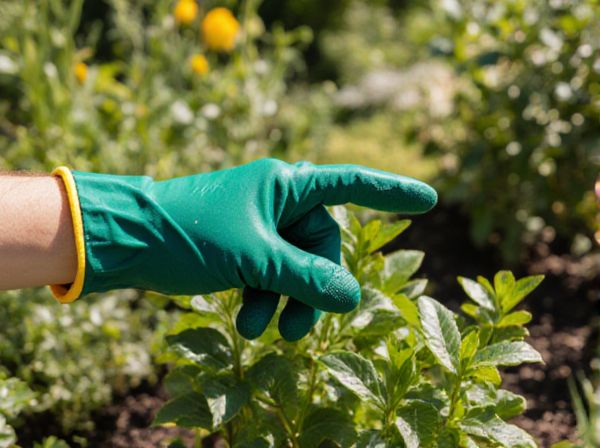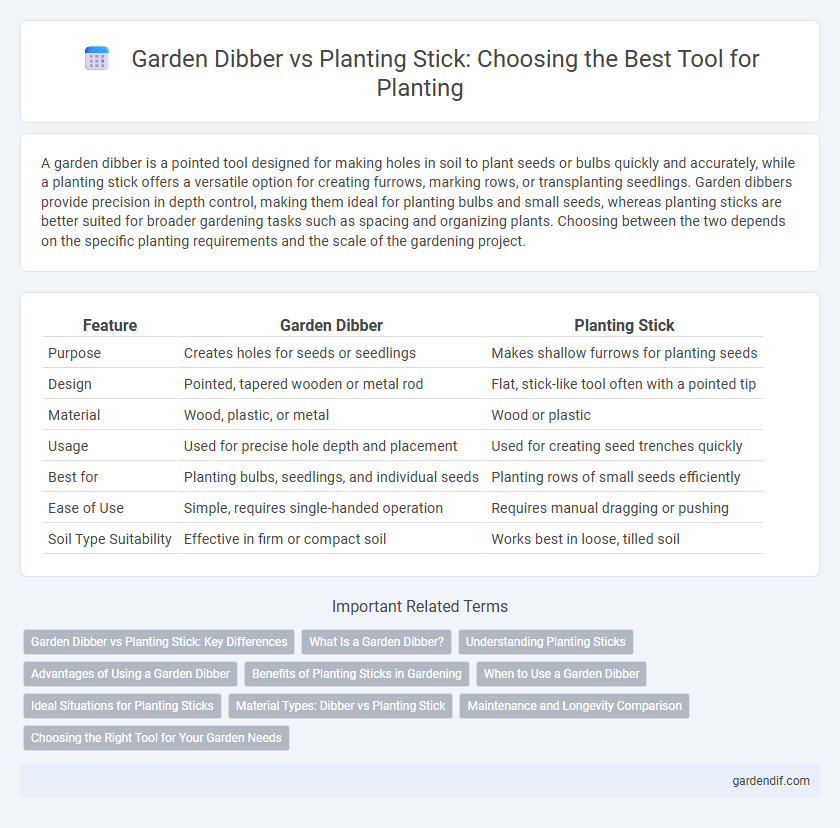
Garden dibber vs Planting stick Illustration
A garden dibber is a pointed tool designed for making holes in soil to plant seeds or bulbs quickly and accurately, while a planting stick offers a versatile option for creating furrows, marking rows, or transplanting seedlings. Garden dibbers provide precision in depth control, making them ideal for planting bulbs and small seeds, whereas planting sticks are better suited for broader gardening tasks such as spacing and organizing plants. Choosing between the two depends on the specific planting requirements and the scale of the gardening project.
Table of Comparison
| Feature | Garden Dibber | Planting Stick |
|---|---|---|
| Purpose | Creates holes for seeds or seedlings | Makes shallow furrows for planting seeds |
| Design | Pointed, tapered wooden or metal rod | Flat, stick-like tool often with a pointed tip |
| Material | Wood, plastic, or metal | Wood or plastic |
| Usage | Used for precise hole depth and placement | Used for creating seed trenches quickly |
| Best for | Planting bulbs, seedlings, and individual seeds | Planting rows of small seeds efficiently |
| Ease of Use | Simple, requires single-handed operation | Requires manual dragging or pushing |
| Soil Type Suitability | Effective in firm or compact soil | Works best in loose, tilled soil |
Garden Dibber vs Planting Stick: Key Differences
Garden dibbers are typically pointed tools designed to create precise holes in the soil for planting seeds or bulbs, offering control and depth accuracy. Planting sticks, often longer and more slender, are used to make narrow grooves or trenches suitable for sowing small seeds or seedlings with minimal soil disturbance. The key differences lie in their shape, intended purpose, and the type of planting technique each facilitates, making dibbers ideal for individual plants and planting sticks better suited for rows or multiple seeds.
What Is a Garden Dibber?
A garden dibber is a pointed hand tool specifically designed for making holes in the soil to plant seeds, bulbs, or seedlings with precision and ease. Unlike a planting stick that may have a flat or rounded tip, a dibber features a tapered, sharp end that penetrates the ground efficiently, helping gardeners maintain uniform planting depths. Its ergonomic design supports consistent spacing and depth, crucial for optimal plant growth and healthy root development.
Understanding Planting Sticks
Planting sticks provide precise control for creating uniform holes in soil, essential for transplanting seedlings and bulbs. Unlike garden dibbers, which are primarily used for making individual planting holes, planting sticks often feature measurement marks to ensure consistent depth and spacing. Mastering the use of planting sticks helps gardeners improve crop yield by optimizing plant placement and root development.
Advantages of Using a Garden Dibber
A garden dibber offers precise hole creation for seeds and seedlings, promoting better root establishment and growth. Its ergonomic design reduces hand strain, making planting more efficient and comfortable compared to a simple planting stick. The tapered, pointed tip of a dibber allows for consistent hole depths, enhancing seed germination success rates.
Benefits of Planting Sticks in Gardening
Planting sticks offer precise depth control, ensuring seeds are planted at optimal depths for better germination rates. Their lightweight and durable design enhances ease of use, reducing strain during prolonged gardening tasks. Using planting sticks also promotes efficient soil aeration, improving root development and overall plant health.
When to Use a Garden Dibber
Use a garden dibber when planting seeds or seedlings that require precise, uniform holes in soil beds or containers. This tool excels in creating consistent planting depths, especially for root vegetables, bulbs, and small plants. Opt for a garden dibber over a planting stick when accuracy and speed are essential for spacing and depth control in gardening tasks.
Ideal Situations for Planting Sticks
Planting sticks excel in ideal situations involving precise seed placement in small garden beds or tight spaces, ensuring accurate depth and spacing for optimal growth. Their slim, pointed design allows gardeners to create uniform holes for seedlings or seeds without disturbing surrounding soil or existing plants. Best suited for delicate transplants and container gardening, planting sticks enhance efficiency and promote healthy root development in controlled planting environments.
Material Types: Dibber vs Planting Stick
Garden dibbers are commonly crafted from hardwood, plastic, or metal, offering durability and ease of use for creating precise planting holes. Planting sticks often feature lightweight materials such as aluminum or fiberglass, providing flexibility and resistance to corrosion for various soil types. The material choice directly impacts the tool's lifespan, grip comfort, and suitability for different gardening tasks.
Maintenance and Longevity Comparison
Garden dibbers, typically made from durable hardwood or metal, require minimal maintenance and offer excellent longevity due to their sturdy construction and resistance to wear. Planting sticks, often crafted from lighter materials like plastic or bamboo, may need more frequent replacement as they are prone to breaking or weathering under continuous outdoor use. Proper cleaning and storage of both tools can extend their lifespan, but garden dibbers generally outperform planting sticks in terms of durability and long-term maintenance needs.
Choosing the Right Tool for Your Garden Needs
Selecting the right garden tool depends on the specific task and soil conditions; a garden dibber excels at creating uniform planting holes ideal for seeds or bulbs, while a planting stick offers versatility for transplanting seedlings and marking rows. Dibbers provide precision and ease for consistent depth, optimizing seed germination rates, whereas planting sticks allow for varied hole sizes and adaptability in different garden beds. Understanding these functional distinctions ensures efficient planting, promotes healthy root development, and enhances overall garden productivity.
Garden dibber vs Planting stick Infographic

 gardendif.com
gardendif.com